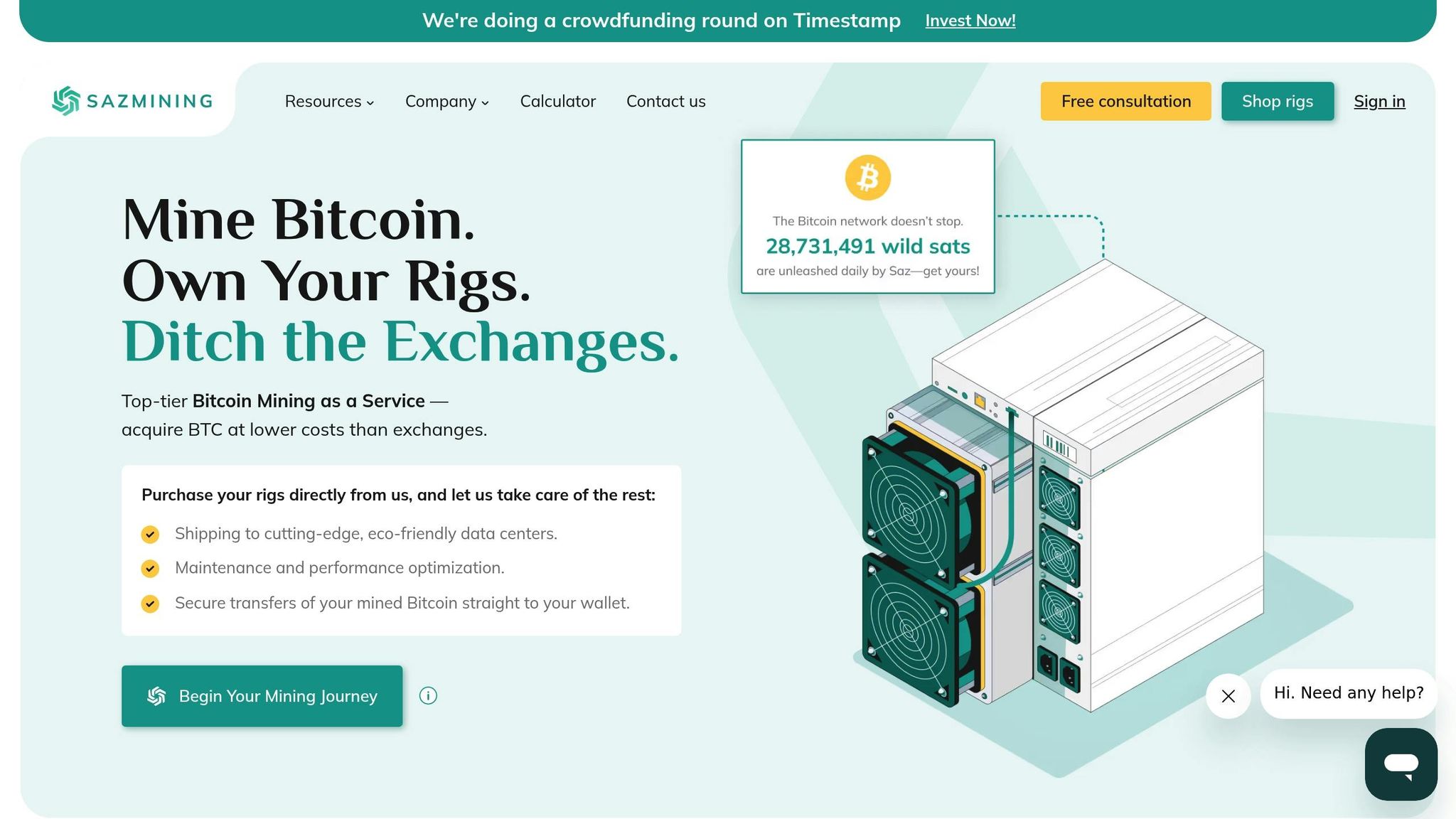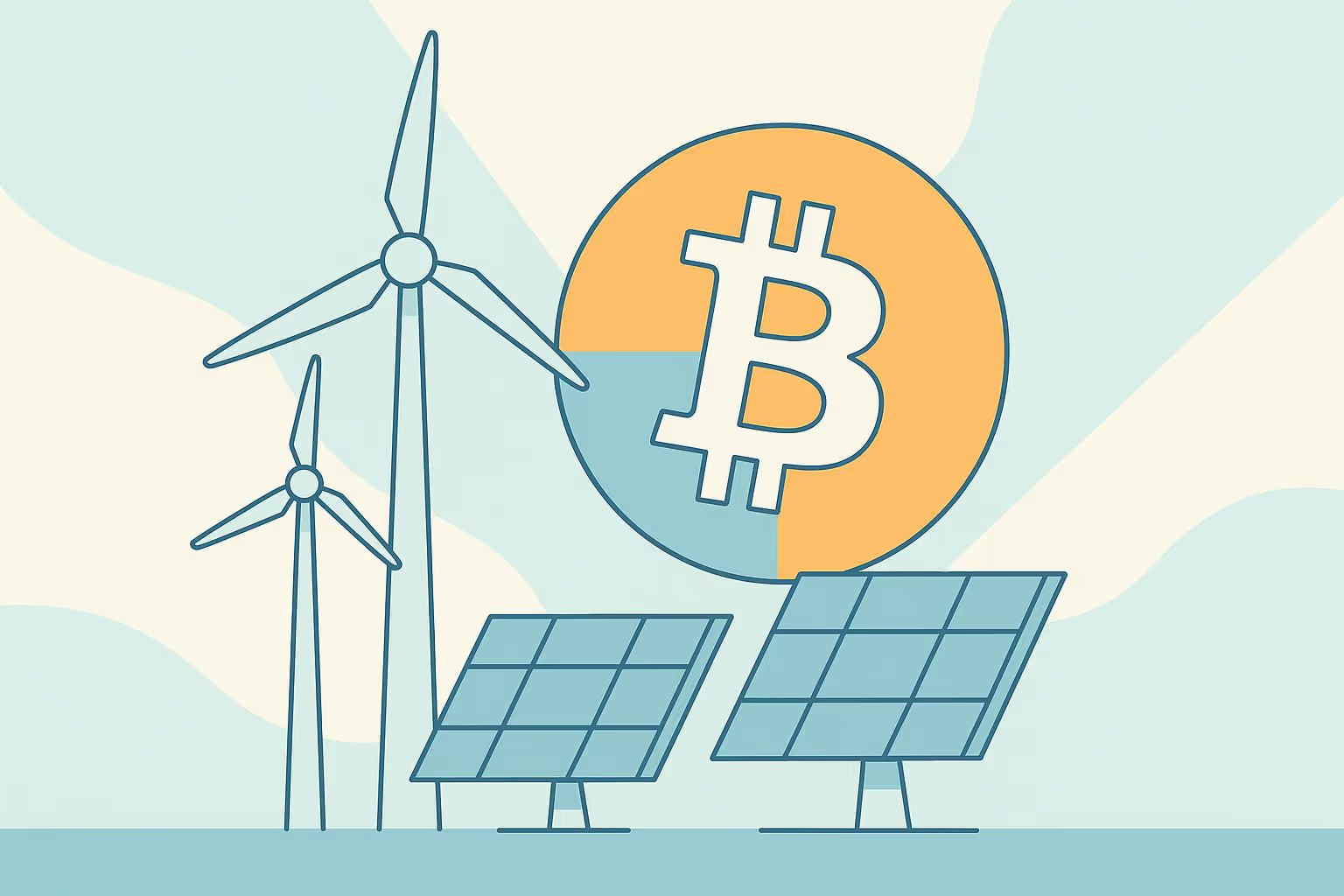Bitcoin mining is becoming more efficient and predictable thanks to renewable energy. By 2025, over 52% of global mining operations use sources like wind, hydro, and solar, reducing energy costs and stabilizing payouts. Here's why this shift matters:
- Lower Costs: Renewable energy is often cheaper than fossil fuels. For instance, solar-powered mining can achieve a return on investment in 3.5 years, compared to 8.1 years for grid-powered setups.
- Stable Energy Prices: Fixed-rate contracts with renewable providers protect miners from fluctuating electricity costs, ensuring consistent payouts.
- Environmental Impact: Renewable-powered mining reduces carbon emissions significantly, with the sector cutting its footprint to 39 million metric tons of CO₂ by 2025.
- Grid Support: Miners help stabilize grids by using surplus renewable energy during low demand and reducing usage during peak times.
Companies like Sazmining lead the way by offering fixed-rate renewable energy contracts, transparent pricing, and direct Bitcoin payouts, making mining operations more reliable and efficient. This transition benefits miners financially while addressing energy challenges.
Energy Costs in Bitcoin Mining
Energy Costs Drive Mining Profitability
Energy consumption is the biggest expense for Bitcoin mining, making up 70-80% of total operational costs. This makes electricity pricing a key factor in determining whether mining operations can remain profitable or are forced to shut down.
To put it into perspective, the Bitcoin network uses about 173 terawatt-hours (TWh) of electricity annually. That’s roughly the same as the electricity consumption of a country like Poland. This accounts for about 0.4% of global annual electricity consumption, illustrating the immense energy demands miners face.
High electricity costs can quickly erode profits, especially during times when Bitcoin prices dip or network difficulty rises. Even small changes in energy prices can have a big impact on profitability, pushing miners to constantly search for the cheapest energy options.
Adding to the challenge is the volatility of grid electricity prices. For example, in Texas, cryptocurrency mining has contributed to an over 30% increase in electricity costs for residents. This unpredictability makes it tough for miners to plan for the long term, as they must frequently adjust operations based on fluctuating grid prices and demand. To stay competitive, many miners are turning to more stable and cost-effective energy alternatives.
Renewable Energy Reduces Operating Costs
Renewable energy is becoming an attractive option for Bitcoin miners looking to cut costs. Sources like solar, wind, and hydropower have become cheaper thanks to advancements in technology and economies of scale. These renewable options often provide a cost advantage over traditional grid electricity, which in many regions still depends heavily on fossil fuels.
Data backs up the benefits of renewables. A study using California Independent System Operator (CAISO) data from 2018 to 2020 showed that wind and solar energy could be a viable option for mining, especially during times when Locational Marginal Prices (LMPs) drop to low or even negative levels. During these periods, miners can take advantage of surplus renewable energy, sometimes even getting paid to use excess electricity that utilities need to offload.
"The Power agreement they negotiated on behalf of their customers is significantly better (and therefore more profitable) than what you pay elsewhere."
– Patrick Atkinson, Sazmining Customer
The savings with renewables go beyond just cheaper electricity. For instance, switching to solar energy for Bitcoin mining can save developers millions while also preventing tens of thousands of tons of carbon dioxide emissions every year.
Mining operations also benefit from being flexible with energy use. By adjusting their electricity consumption to match grid demand, miners can participate in demand response programs. These programs offer financial rewards for reducing energy use during peak times, creating an additional revenue stream alongside Bitcoin mining rewards.
Sazmining is a great example of this strategy in action. They operate data centers in places like Paraguay and Norway, relying on 100% carbon-free energy, including hydropower. By negotiating favorable energy agreements and avoiding extra electricity charges, Sazmining helps miners access affordable, renewable energy. This approach not only keeps operational costs low but also ensures miners remain competitive, even as traditional grid-powered operations face rising costs.
"They exclusively use cheap, renewable energy."
– Bryce McDowell, Sazmining Customer
How Renewable Energy Improves Bitcoin Payout Transparency
Stable Energy Costs Create Predictable Payouts
Renewable energy is reshaping Bitcoin mining by offering miners a way to predict payouts more reliably. Traditional mining operations often face fluctuating energy costs due to variable utility rates and surcharges, which can disrupt payout accuracy. Renewable energy contracts, on the other hand, provide stability.
Solar, wind, and hydropower agreements typically lock in fixed or indexed rates over several years. Since electricity makes up 70–80% of mining expenses, having stable energy pricing allows miners to plan payouts with greater precision. This is a game-changer compared to fossil fuel-based operations, where energy costs can swing wildly.
In regions like Texas and the Pacific Northwest, miners have partnered with renewable energy providers to secure long-term, stable electricity rates. These partnerships help shield them from price volatility and regulatory risks. For instance, solar-powered mining facilities have reported not only annual cost savings but also more consistent payout schedules. A 2024 study revealed that such setups could achieve a return on investment in just 3.5 years, compared to 8.1 years when selling electricity back to the grid.
Sazmining's Transparency Methods

Sazmining sets a high bar for transparency by combining renewable energy with clear payout structures. Operating data centers powered entirely by carbon-free energy - like hydropower in Paraguay and Norway - the company offers customers fixed-rate electricity contracts.
"We provide long-term, fixed-rate contracts on electricity - so unlike many mining providers, you won't get hit with surprise energy price hikes." – Sazmining
Beyond stable energy pricing, Sazmining ensures its customers only pay when the mining rigs are operational and profitable. There are no hidden fees for rigs or electricity. Instead, the company earns a straightforward percentage of mining profits: 15% in Paraguay, 20% in Norway, and 15% in Ethiopia. Bitcoin rewards go directly from the mining pool to customers' wallets, meaning Sazmining never holds or controls the mined Bitcoin.
This transparent approach has earned customer trust. For example, Hoss, a Sazmining customer, shared:
"This is, in my experience, the most forthcoming and upfront company I've ever done business with, when it comes to any questions I have."
Sazmining also provides real-time monitoring tools and dashboards that give customers a clear view of energy consumption and mining performance. These features allow users to track their earnings and expenses effortlessly. By relying on renewable energy and transparent practices, Sazmining delivers payout reliability that traditional, volatile energy models simply can't match.
Renewable Energy and Grid Stability
Using Excess Energy During Low Demand
Bitcoin mining has emerged as a surprising ally in stabilizing the electrical grid by tapping into surplus renewable energy during times of low demand. This approach not only provides miners with access to affordable electricity but also helps prevent energy from going to waste.
One of the challenges with renewable energy is that its production doesn’t always align with when people need it most. For instance, solar energy generation peaks around midday, while wind energy often surges at night. This mismatch can create imbalances in traditional grids, leading to wasted energy. Bitcoin miners address this by ramping up operations when there’s an energy surplus and scaling back during peak demand periods. This dynamic helps smooth out fluctuations in the grid.
A great example of this can be seen in Texas, where mining operations utilize excess wind energy during off-peak hours. During periods of high demand - like sweltering summer afternoons when air conditioners are running full blast - mining operations ease their energy use, reducing stress on the grid. This dual role not only supports grid stability but also provides miners with an additional revenue stream.
The numbers tell an interesting story: as of 2025, 52.4% of global Bitcoin mining will rely on renewable energy, cutting the sector’s carbon footprint to 39 million metric tons of CO₂ worldwide. Even more striking, crypto mining accounts for just 0.6% to 2.3% of the total electricity consumption in the U.S..
Working with Variable Renewable Energy Sources
Bitcoin mining operations have also adapted to the unpredictable nature of renewable energy by timing their activities to align with peak energy production. For example, solar-powered mining facilities ramp up during the sunniest hours of the day and scale down as solar output wanes. Similarly, wind-powered operations increase their activity during nighttime or early morning hours when wind energy is at its strongest.
The secret to making this work lies in operational flexibility. By adjusting their energy use to match peak production, miners not only cut costs but also boost profitability. Collaborations with energy providers further enhance grid stability, ensuring reliable power for local communities. This approach is supported by long-term renewable energy contracts, which provide miners with predictable costs and consistent payouts.
The financial upside is clear: miners who adapt to the ebb and flow of renewable energy can capitalize on low-cost electricity during peak production, maintaining a profitable operation. This adaptability strengthens the mining industry’s reliance on renewables while contributing to a more stable and efficient energy grid.
sbb-itb-c71a7d0
How Bitcoin Helps Create Energy Abundance
Economic Benefits and Future of Renewable-Powered Mining
Renewable-powered mining is not just about energy stability - it’s proving to be a game-changer for profitability and long-term economic growth.
Profitability of Renewable Energy in Mining
One of the biggest advantages of renewable energy in Bitcoin mining is its ability to significantly cut operational costs. Electricity, which often costs around $0.17 per kWh in the U.S., is the largest expense for miners. By tapping into renewable sources, especially during off-peak hours when locational marginal prices can drop sharply, miners can slash their energy bills.
The numbers back this up. A 2024 study published in Heliyon revealed that solar-powered mining operations outperform traditional energy sales to utilities in terms of economic returns. These operations enjoy faster payback periods, making them not only environmentally conscious but also financially appealing.
Another key benefit is stability. Fixed-rate renewable energy contracts shield miners from the unpredictable price swings of fossil fuels, which can quickly eat into profits. This predictability enables better financial planning and ensures more consistent Bitcoin payouts over time.
Take Sazmining as an example. They’ve embraced this cost-efficient model through strategic energy agreements. Patrick Atkinson, a Sazmining customer, shared his experience:
"The Power agreement they negotiated on behalf of their customers is significantly better (and therefore more profitable) than what you pay elsewhere."
Challenges and Opportunities
While the economic advantages are clear, renewable-powered mining isn’t without its hurdles. Regulatory restrictions and infrastructure issues - like zoning laws and supply chain challenges for critical materials such as cobalt and nickel - pose significant obstacles. These challenges, however, also point to areas of opportunity.
One major operational issue is the mismatch between renewable energy supply and mining demand. During periods of low renewable output, miners often rely on traditional energy sources, which can increase costs and dilute the environmental benefits. To address this, mining operations need advanced energy management systems and flexible strategies to adapt to these fluctuations.
Despite these challenges, forward-thinking miners are finding ways to turn them into opportunities. For instance, co-locating with renewable energy projects allows miners to directly use surplus power, often at discounted rates. This not only reduces costs for miners but also provides renewable energy developers with an extra revenue stream during early project stages.
The regulatory environment is also shifting in favor of sustainable mining. Federal policies like the Inflation Reduction Act are encouraging renewable energy adoption, while growing public demand for cleaner Bitcoin mining is pushing the industry toward greener practices. Miners who move early to align with these trends can gain a competitive edge through cost savings and better market positioning.
Technological advancements in energy storage and grid management are further opening doors. As battery storage becomes more affordable and smart grid technologies improve, storing and deploying renewable energy is becoming increasingly practical. These innovations could help overcome the variability of renewable energy, making operations more efficient and reliable.
Looking ahead, the global crypto mining market - valued at $2.2 billion in 2024 and expected to grow to $3.3 billion by 2030 - shows immense potential for miners who capitalize on renewable energy. Early adopters are not only cutting costs but also positioning themselves to thrive in a rapidly expanding market, all while staying ahead of regulatory and environmental demands.
Conclusion: Moving Toward Cleaner Bitcoin Mining
The increasing reliance on renewable energy is reshaping Bitcoin mining in ways that benefit both the industry and the environment. By adopting renewable energy sources, miners can enjoy more predictable energy costs, which helps them avoid sudden electricity price surges. At the same time, flexible energy usage patterns contribute to stabilizing electrical grids. This transition doesn’t just make operations cleaner - it also leads to more consistent and reliable economic outcomes.
From a financial perspective, renewable-powered mining operations often see quicker returns on investment and lower costs compared to those using traditional energy sources. These advantages highlight how renewables can boost profitability while significantly reducing the environmental footprint of Bitcoin mining.
Sazmining offers a real-world example of this shift. Their operations run entirely on carbon-free energy, spread across global data centers. With a transparent model that includes fixed-rate electricity contracts and direct Bitcoin payouts to customer wallets, Sazmining ensures fees are only applied when rigs are profitable. There are no hidden markups on electricity or equipment, setting a standard for sustainable and fair mining practices.
Looking forward, advancements in energy storage, smarter grid technologies, and supportive regulations are expected to further enhance renewable-powered mining. Cleaner Bitcoin mining not only reduces carbon emissions but also creates a more stable and profitable ecosystem. Shifting to renewable energy is a crucial step toward a sustainable and economically sound future for Bitcoin mining.
FAQs
How does renewable energy influence the profitability and reliability of Bitcoin mining?
Using renewable energy for Bitcoin mining offers a practical way to cut down on electricity costs - one of the biggest expenses in the mining process. By lowering energy expenses, miners can increase their profit margins and create a more financially viable operation over the long term.
On top of that, renewable energy sources like solar and wind often bring more stable pricing compared to traditional energy, which tends to fluctuate. This stability helps miners achieve more predictable and consistent payouts. Opting for eco-friendly energy solutions not only helps reduce the environmental footprint of Bitcoin mining but also ensures operations remain efficient and profitable.
How does using renewable energy benefit Bitcoin mining and the environment?
Switching to renewable energy for Bitcoin mining offers clear benefits for the planet. By cutting down on greenhouse gas emissions, it helps reduce the carbon footprint of mining operations, which is a step toward addressing climate change.
Renewable energy sources - like wind, solar, and hydro - are not only cleaner but also kinder to the environment compared to traditional fossil fuels. These energy options align well with the high energy demands of Bitcoin mining, providing a more sustainable way to power the process. Choosing renewables allows miners to operate efficiently while playing a part in building a cleaner, healthier future.
How can fixed-rate renewable energy contracts help Bitcoin miners control energy costs?
Fixed-rate renewable energy contracts give Bitcoin miners a steady and predictable electricity cost, shielding them from the ups and downs of fluctuating energy prices. This stability is key for miners, as it allows for more precise planning of operational expenses, making budgeting and financial forecasting much easier.
Sazmining takes a green approach to Bitcoin mining by providing a fully managed service. They host customer-owned mining rigs in environmentally-friendly data centers, ensuring transparency and top performance. Customers benefit from direct Bitcoin payouts to their wallets, all while tapping into renewable energy sources.

